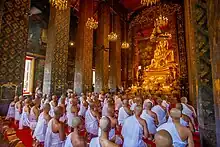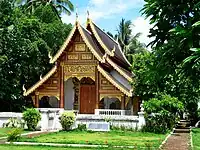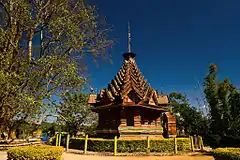戒堂
各地传统
缅甸语中,戒堂称为“登”(緬甸語:;Thein),来自巴利语的,意译为“界”。在缅甸以奘房为中心的佛寺中,戒堂是重要且常见的建筑,但亦有独立而建的做法[2][4]。缅甸掸族寺庙的戒堂称为“辛”(;Sim),是专为僧人活动而设的场所[5][6]。
在泰国,戒堂称为“乌博索”(泰語:;Ubosot)或“博”(;Bot),源自巴利语的,意为举行布萨仪式的场所[7]。戒堂是泰民族的洼寺式庙宇的主要建筑,亦用作公共用途[2][5] 。在泰国中部的佛寺中,戒堂是全寺的中心;泰北寺庙则以舍利塔为中心[5]。寺庙中最重要的佛像就通常在戒堂中供奉。
泰民族的传统是用八块镇邪石(;Bai sema)划定戒堂的结界。这种做法可以追溯到陀羅缽地文明时期[3]。在南传佛教寺庙中,精舍和戒堂都是供奉佛像的主要礼佛场所,二者最大的区别即戒堂周围是有镇邪石划出结界的。
参考文献
- Murphy, Stephen A. . . River Books & The Siam Society. 2014 [2023-03-12]. (原始内容存档于2023-03-12).
- O'Connor, Richard A. . Arts Asiatiques. 2009, 64 (1): 116–123. doi:10.3406/arasi.2009.1692.
- Kieffer-Pülz, Petra. . Journal of the International Association of Buddhist Studies. 1997, 20 (2): 141–153 [2023-03-12]. ISSN 0193-600X. (原始内容存档于2023-03-12) (英语).
- ဇင်ဦး. . Ministry of Information. [2020-05-17] (缅甸语).
- Tannenbaum, Nicola. . Crossroads: An Interdisciplinary Journal of Southeast Asian Studies. 1990, 5 (1): 23–41. JSTOR 40860287.
- Sao Tern Moeng. . Dunwoody Press. 1995 [2023-03-12]. (原始内容存档于2021-03-08).
- Architecture of Thailand. A Guide to Traditional and Contemporary Forms. Nithi Sthapitanonda; Brian Mertens.
延伸阅读
- Karl Döhring: Buddhist Temples Of Thailand. Berlin 1920, reprint by White Lotus Co. Ltd., Bangkok 2000, ISBN 974-7534-40-1
- K.I. Matics: Introduction To The Thai Temple. White Lotus, Bangkok 1992, ISBN 974-8495-42-6
- No Na Paknam: The Buddhist Boundary Markers of Thailand. Muang Boran Press, Bangkok 1981 (no ISBN)
- Carol Stratton: What's What in a Wat, Thai Buddhist Temples. Silkworm Books, Chiang Mai 2010, ISBN 978-974-9511-99-2
This article is issued from Wikipedia. The text is licensed under Creative Commons - Attribution - Sharealike. Additional terms may apply for the media files.

.jpg.webp)



